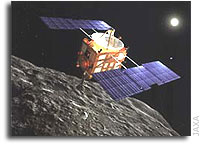Station Keeping History of Hayabusa with Asteroid Itokawa

Hayabusa arrived at what we call the Gate Position, about 20 km from Itokawa on September 12th. Since then to 21st, Hayabusa had kept the relative position control (Station Keeping) via the Optical Hybrid Navigation. A three dimensional view of the trajectory as well as its time history are shown below.
The coordinate used here is, so called, HP (Home Position) frame, in which the Z axis is taken to the Earth direction and Y-axis is southward in ecliptic frame and normal to the plane that is spanned by Sun-to-Itokawa and Sun-to-Earth lines and X-axis should constitute the right-hand coordinate. The station keeping maneuver maintains its altitude (Z-position) at the same time controls the Itokawa direction at the center in X-Y plane. The control box defined is a little loosened so that the number of corrections can be minimized. Note even 1 cm/second velocity residual leads to the drift of up to 1 km per day, and this station keeping is performed very carefully.
As the following figures indicate, the station keeping has been carried out satisfactorily. Next week, Hayabusa lowers its altitude to the Home Position, where this task will be much harder due to the high sensitivity. The operation team will continue making an intensive effort to accomplish the proximity observation. HP Coordinate Station Keeping History
[Station Keeping Time History]

[Station Keeping at a glance]

The figure shows the station keeping locus at a glace including Itokawa. Here, the size of Itokawa is not in scale. This tells how accurately the spacecraft position has been controlled. The next web report will introduce how Hayabusa lowers its altitude and reach the Home Position.








